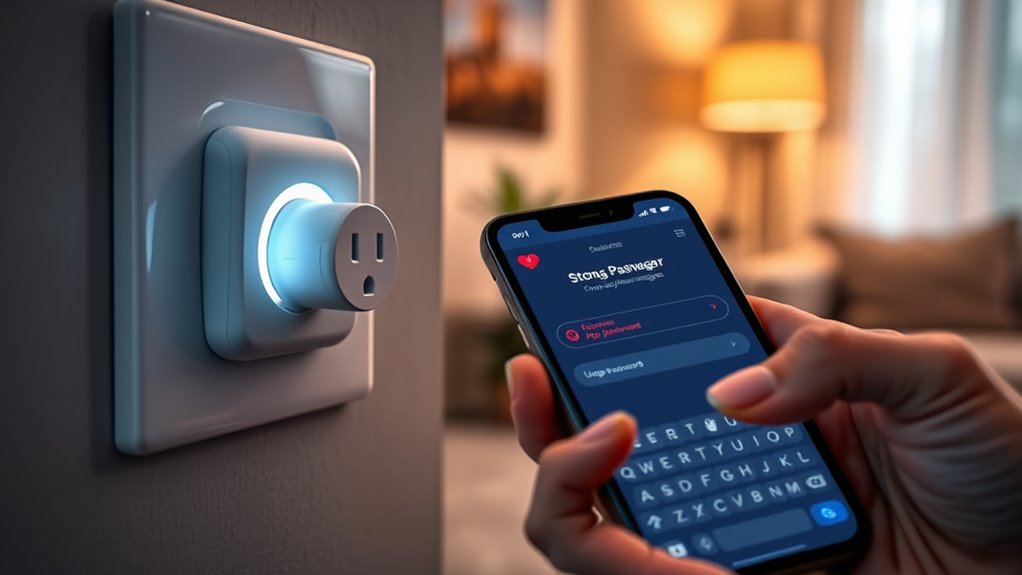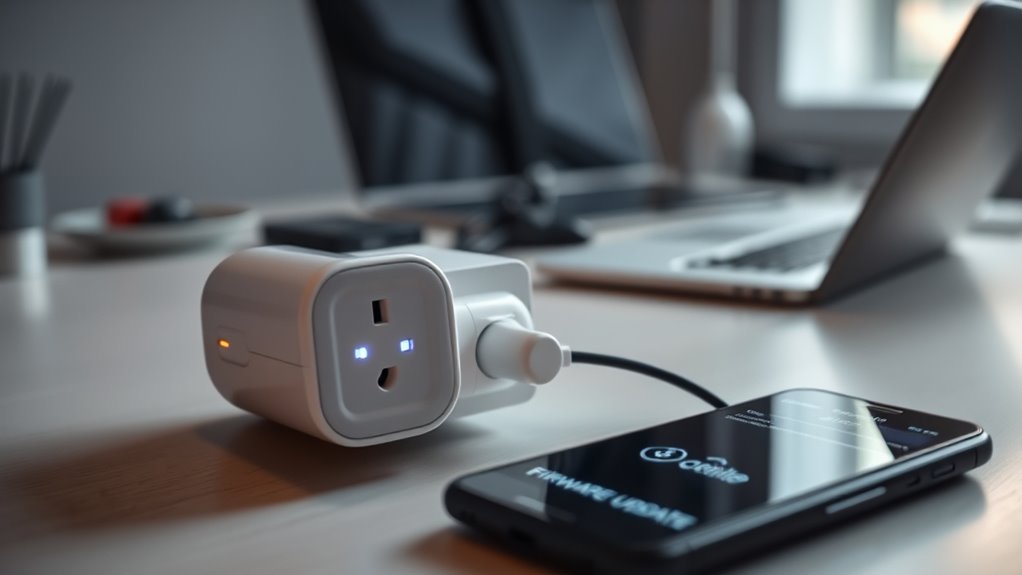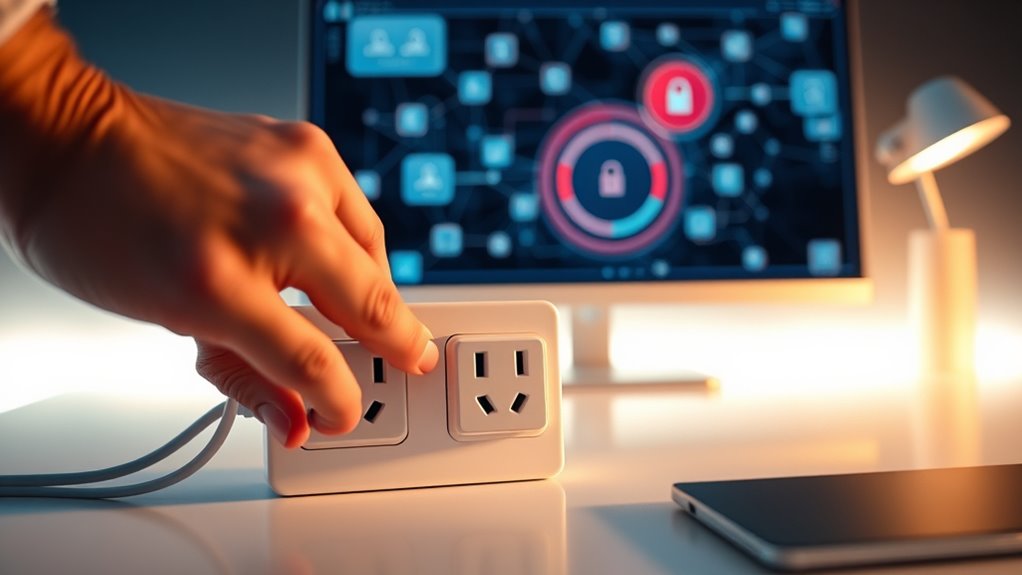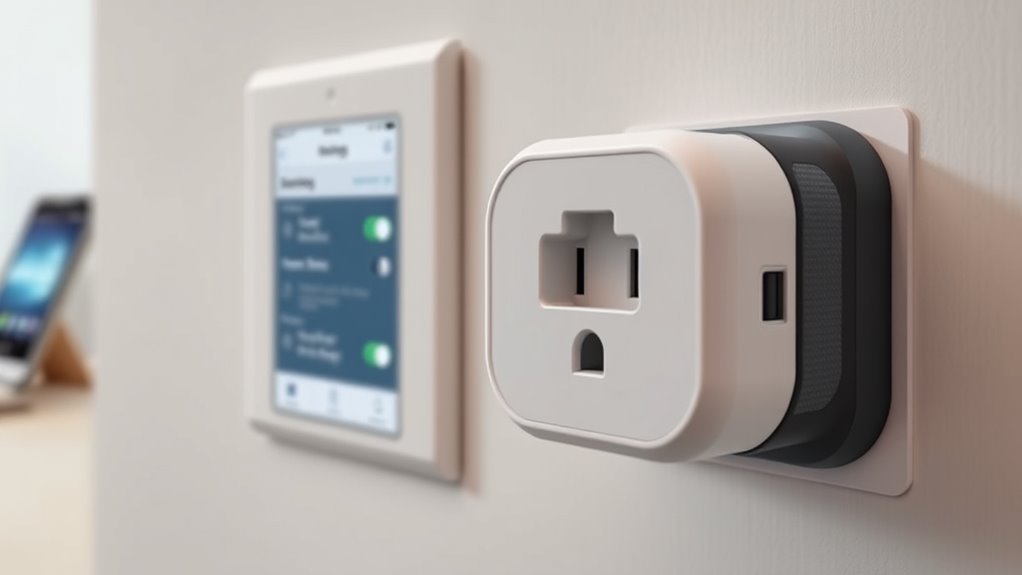To secure your IoT devices and smart plugs from hacks, use strong, unique passwords and enable two-factor authentication, avoiding default credentials. Support encryption protocols like WPA3 and keep firmware and software updated regularly. Segment your network so smart devices are isolated from critical systems, and disable unnecessary features or remote access. Monitor device activity and network traffic consistently for unusual behavior. Continuing on, you’ll discover more effective steps to enhance your smart device security.
Key Takeaways
- Use strong, unique passwords and enable two-factor authentication for all smart plug accounts.
- Keep firmware and software updated regularly to patch security vulnerabilities.
- Segment your network by creating a dedicated guest Wi-Fi for smart plugs to isolate them from sensitive devices.
- Disable unnecessary features like remote management, voice control, and cloud services if not needed.
- Monitor device activity continuously and set up alerts for suspicious or unusual behavior.
Use Strong and Unique Passwords for Your Smart Plugs

To keep your smart plugs secure, it’s crucial to use strong and unique passwords. This enhances your device security and prevents unauthorized access. Choose passwords that are at least 12-16 characters long, combining uppercase and lowercase letters, numbers, and symbols. Avoid default passwords provided by manufacturers and change them immediately after setup. Creating unique passwords for each smart plug ensures that if one device is compromised, others remain protected. Using passphrases—long, random sentences or word combinations—adds extra strength to your security settings. Good password management is essential; regularly update your passwords and consider enabling two-factor authentication if available. Incorporating mindfulness techniques into your routine can help you stay attentive to security practices and avoid overlooking important updates or security alerts. By doing so, you make it much harder for hackers to breach your smart plugs and keep your network safer.
Enable Encryption and Secure Communication Protocols

After setting strong, unique passwords for your smart plugs, ensuring your devices communicate securely adds an extra layer of protection. Look for smart plugs that support encryption and secure communication protocols like HTTPS, TLS, or WPA3, which encrypt data in transit and prevent eavesdropping. Regularly check for firmware updates and security patches from the manufacturer, as these often improve encryption standards and fix vulnerabilities. Enable any built-in encryption settings, such as Wi-Fi encryption or secure pairing methods, to safeguard the communication between your smart plug and your network. Avoid using default or unsecured protocols like HTTP or open Wi-Fi networks, which leave your devices vulnerable. Using WPA3, the latest Wi-Fi security standard, helps enforce encryption across your entire network, adding an extra layer of protection. Additionally, understanding the contrast ratio of your network devices can help ensure optimal security settings are in place for your smart home environment. Incorporating a security-focused approach when configuring your network can further mitigate potential hacking risks. Recognizing that strong encryption protocols are essential for defending against cyber threats can motivate you to prioritize secure configurations. Furthermore, employing multi-factor authentication where available can significantly enhance your device security.
Keep Firmware and Software Up-to-Date Regularly

Keeping your smart plug’s firmware and software up-to-date is essential for maintaining security. Regular firmware updates include security patches that fix vulnerabilities hackers might exploit. Check the manufacturer’s website or app frequently for available software upgrades, and enable automatic updates if possible. Applying firmware updates promptly not only patches known security flaws but also enhances device stability, ensuring reliable operation. Outdated firmware can harbor vulnerabilities that leave your smart plug open to attacks, risking unauthorized access or control. By staying current with updates, you reduce these risks and improve overall performance. Remember, neglecting firmware and software updates leaves your device exposed to evolving threats. Make it a habit to verify and install updates regularly to keep your smart plug secure and functioning ideal. Additionally, using secure Wi-Fi networks can help protect your devices from unauthorized access and potential hacks. Maintaining a secure network with strong passwords and encryption further strengthens your device security. Regular security assessments and keeping informed about latest threats can also help you stay ahead of potential vulnerabilities, especially as cybersecurity landscapes evolve.
Segment Your Network to Isolate Smart Devices

Segmenting your network to isolate smart devices adds a crucial layer of security by preventing potential attackers from accessing your more sensitive resources. Using network segmentation helps contain attack vectors by separating smart plugs from your main devices. Creating a dedicated guest network for your smart plugs ensures they can’t access critical systems or data. Many routers support device isolation, blocking communication between devices on the same network and reducing risks. Regularly review connected devices and their segments to maintain secure IoT devices and identify unauthorized access. Additionally, employing best vacuum techniques to keep your environment clean can reduce dust and allergens that might interfere with smart device operation. Implementing network monitoring tools can further help detect unusual activity and potential threats early. Conducting regular firmware updates for your smart devices is essential to patch vulnerabilities and improve security. Ensuring your network is securely configured helps prevent vulnerabilities that could be exploited by cybercriminals. Strengthening your device authentication processes can further prevent unauthorized access to your smart devices.
Disable Unnecessary Features and Remote Access

To boost your smart plug’s security, turn off features you don’t need, like voice control or cloud services. Disable remote management and limit access permissions to prevent outsiders from controlling your devices. Regularly review your settings to make certain only essential functions are active and accessible locally. Incorporating wall organization systems can help you keep track of device settings and accessories, ensuring your smart home remains secure and clutter-free. Being aware of security vulnerabilities in IoT devices can further help you identify potential risks and mitigate them effectively. Additionally, understanding emotional alignment and maintaining a mindful approach to device management can enhance your overall digital security practices. Recognizing user behavior patterns can also assist in identifying unusual activity that might indicate security breaches. Staying informed about device compatibility ensures your smart gadgets work securely within your existing home network.
Turn Off Unused Features
Disabling unused features like remote access, voice control, or Bluetooth is a key step in securing your smart plug. By turning off unnecessary functionalities, you reduce security vulnerabilities and limit entry points for hackers. Many smart plugs come with default settings that enable remote access, so reviewing device settings is essential. When you disable remote access, your device can only be controlled locally, strengthening network security. Regularly check for features like cloud syncing or automation triggers and turn them off if you don’t need them. This not only minimizes potential breaches but also conserves device resources. Remember, manufacturers often leave default settings enabled—manually disabling unused features helps ensure your smart plug operates with the least possible security vulnerabilities. Additionally, default configurations can pose security risks if not reviewed and adjusted accordingly. Ensuring that security best practices are followed when configuring your device can further help prevent unauthorized access. Implementing a comprehensive security approach that includes these steps enhances the overall protection of your IoT devices. Being aware of device settings and adjusting them appropriately is a crucial aspect of maintaining a secure smart home environment.
Disable Remote Management
Turning off remote management on your smart plug is essential for preventing unauthorized access from outside your home network. Many smart plugs have remote management enabled by default, which can increase your attack surface if left unchecked. By disabling this feature through the device settings or app, you limit control to your local network, greatly boosting your security. This reduces the risk of hackers gaining control over your smart plug via cloud servers or external connections. Regularly reviewing your device settings and turning off unnecessary features like remote management helps protect your IoT devices from exploitation. Keeping remote access disabled ensures that only trusted devices within your Wi-Fi network can control your smart plug, making your overall smart home environment more secure.
Limit Access Permissions
Limiting access permissions on your smart plugs is essential for maintaining security, especially by disabling unnecessary features and remote access functions. By managing your IoT devices carefully, you reduce the risk of unauthorized access and potential breaches. Review device settings regularly to ensure only essential permissions are granted, avoiding default credentials and shared accounts. Turn off features like voice control or automation integrations that aren’t needed, as they can create attack vectors. Disable remote access options to prevent external control. Use restricted privileges by creating separate user accounts and avoid enabling features like UPnP, which can open ports automatically. Keeping your device settings tight helps you control who can access your smart plugs, making your smart home safer.
Monitor Device Activity and Network Traffic Consistently

To keep your smart plugs secure, you need to monitor their activity and network traffic regularly. Set up alerts for unusual behavior and analyze traffic patterns to catch suspicious activity early. Using tools like Wireshark or network segmentation helps you stay on top of potential threats.
Set Up Alerts
Setting up alerts to monitor your smart plugs’ activity is essential for maintaining security. Alerts keep you informed of suspicious behavior and unauthorized access, strengthening your network security. Enable automated notifications within your firewall or security software to get immediate updates on unusual device activity. Use real-time monitoring tools like Wireshark or Nagios to track traffic and detect anomalies promptly. Regularly review device logs and network traffic reports to identify unexpected data transfers or connections to unknown IP addresses. Additionally, leverage your router’s admin interface or security app to receive instant alerts for abnormal activity. These proactive measures ensure you’re always aware of potential threats and can respond quickly, keeping your smart plugs and network safe.
- Enable automated alerts for suspicious behavior
- Use real-time monitoring tools for device activity
- Review logs regularly for anomalies
- Set notifications through your router or security app
Analyze Traffic Patterns
Regularly analyzing your network traffic logs helps you spot unusual patterns that could signal security issues with your smart plugs. Monitoring traffic patterns enables you to identify unusual data flows, such as spikes in data volume or remote access attempts. Use tools like Wireshark or dedicated network monitoring software to analyze traffic and establish normal device activity benchmarks. Pay attention to unexpected data transfers or connections to unknown IP addresses, which may trigger alerts. Setting up these alerts allows quick responses to potential threats. Segment your network to isolate smart plugs, making traffic analysis more straightforward and suspicious activity easier to detect. Consistent review of network traffic guarantees you stay ahead of potential security breaches, keeping your smart devices safe from hackers.
Frequently Asked Questions
Are Smart Plugs Safe From Hackers?
Smart plugs aren’t entirely safe from hackers if you don’t take precautions. They often have default passwords and outdated firmware, making them vulnerable. You can improve security by changing default credentials, updating firmware regularly, and using strong Wi-Fi passwords. Also, consider network segmentation to isolate your smart devices. Staying vigilant and proactive helps protect your smart plugs from potential cyber threats, keeping your devices and data safer.
How Can We Keep Iot Devices Secure?
You might think your IoT devices are safe, but without proper security, they’re vulnerable. To keep your devices secure, use strong, unique passwords and change default ones immediately. Regularly update firmware, enable multi-factor authentication, and isolate your smart plugs on a separate network. Disable any unnecessary features like remote access, and stay vigilant—these steps markedly reduce the risk of hacks and protect your smart home.
Which of the Following Is a Best Practice for Securing Iot Devices?
You want to secure your IoT devices effectively. One of the best practices is to change default credentials immediately, using strong, unique passwords for each device. Enable multi-factor authentication when possible, keep firmware updated, and disable unnecessary features like remote access. Segment your network for IoT devices to limit potential damage, providing an extra layer of security. These steps help prevent unauthorized access and keep your smart plugs safe from hacks.
What Measures Should Be Taken to Secure Iot Devices?
Think of securing your IoT devices like guarding a treasure chest. You should change default passwords to strong, unique ones, keep firmware updated, and enable network segmentation to isolate your smart plugs. Disable unnecessary features, use WPA3 encryption, and consider a firewall. These steps act as your digital shield, making it much harder for hackers to breach your smart home and protect your connected devices effectively.
Conclusion
Securing your smart plugs is essential since over 60% of IoT devices are vulnerable to attacks. By using strong, unique passwords, enabling encryption, and keeping software updated, you can greatly reduce your risk. Regularly monitoring activity helps catch suspicious behavior early. Remember, taking these simple steps can protect your network and devices from hackers. Don’t wait—secure your smart plugs today to enjoy peace of mind and a safer smart home.









